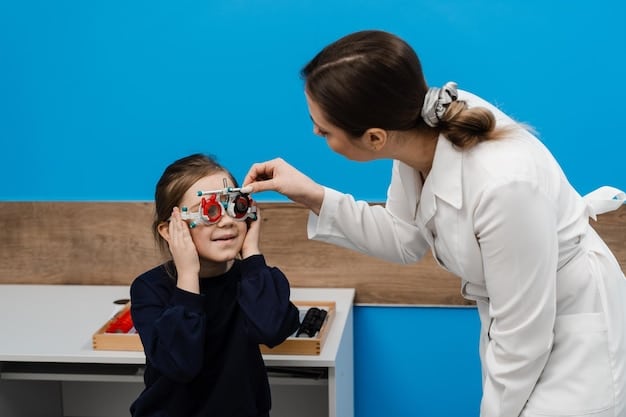The Importance of Regular Eye Exams: Protecting Your Vision in the Digital Age

Regular eye exams are crucial in the digital age for detecting early signs of vision problems, protecting against eye strain from prolonged screen use, and maintaining overall eye health, ensuring clear and comfortable vision.
In today’s digital world, where screens dominate our lives, the importance of regular eye exams: protecting your vision in the digital age cannot be overstated. Prioritizing your eye health is essential for maintaining clear vision and overall well-being.
Why Regular Eye Exams Are Essential
Regular eye exams are more than just checking your vision; they are a comprehensive assessment of your overall eye health. These exams can detect early signs of various eye conditions and diseases, some of which may have no noticeable symptoms in their initial stages.
Early detection and treatment of eye conditions can prevent vision loss and improve your quality of life. Ignoring regular check-ups can lead to irreversible damage and long-term visual impairment.
Detecting Early Signs of Eye Conditions
Many eye conditions, such as glaucoma and macular degeneration, develop gradually and often without any noticeable symptoms. Regular eye exams can help detect these conditions in their early stages, allowing for timely intervention and treatment.
Comprehensive eye exams include various tests to assess your visual acuity, eye pressure, and the health of your optic nerve and retina. These tests can reveal subtle changes that may indicate the presence of an underlying eye condition.
Preventing Vision Loss
Early detection and treatment of eye conditions can significantly reduce the risk of vision loss. Some eye conditions, like glaucoma, can cause irreversible damage to the optic nerve, leading to permanent vision loss if left untreated.
Regular eye exams allow your eye doctor to monitor your eye health and identify any potential problems before they cause significant damage. This proactive approach can help preserve your vision and prevent long-term visual impairment.

Improving Quality of Life
Clear and comfortable vision is essential for performing daily tasks and enjoying life to the fullest. Regular eye exams can help identify and correct vision problems that may be affecting your ability to see clearly.
- Children’s Vision: Regular eye exams are crucial for children to ensure proper visual development and academic success.
- Adults and Seniors: For adults and seniors, eye exams can detect age-related eye conditions and prevent vision loss.
- People with Diabetes:Diabetic patients need regular eye exams for early detection of diabetic retinopathy.
Regular eye exams are essential for maintaining overall eye health and preventing vision loss. These exams can detect early signs of various eye conditions, ensuring timely intervention and treatment.
The Impact of Digital Eye Strain
In the digital age, we spend countless hours staring at screens, whether it’s for work, entertainment, or communication. This prolonged screen use can lead to digital eye strain, a common condition characterized by various uncomfortable symptoms.
Understanding the causes and symptoms of digital eye strain is crucial for protecting your eyes and maintaining comfortable vision. Regular eye exams can help diagnose and manage digital eye strain effectively.
Understanding Digital Eye Strain
Digital eye strain, also known as computer vision syndrome, is a group of eye and vision problems caused by prolonged computer, tablet, and smartphone use. The extended focus required to look at the screen can lead to strain.
Staring at screens for long periods can disrupt your blink rate, leading to dry eyes and discomfort. Reduced blinking prevents the eyes from being adequately lubricated, causing irritation and blurred vision.
Symptoms of Digital Eye Strain
Digital eye strain can manifest in various symptoms, including dry eyes, blurred vision, headaches, and neck and shoulder pain. These symptoms can significantly impact your productivity and overall well-being.
Other common symptoms include eye fatigue, difficulty focusing, and increased sensitivity to light. Recognizing these symptoms early is essential for seeking timely treatment and preventing long-term complications.
Managing and Preventing Digital Eye Strain
There are several strategies that you can implement to manage and prevent digital eye strain. These include adjusting your screen settings, taking regular breaks, and using appropriate eyewear.
Adjusting your screen brightness, contrast, and font size can reduce eye strain. The “20-20-20” rule—taking a 20-second break every 20 minutes to look at something 20 feet away—can also help relieve eye fatigue.
Digital eye strain is a common condition in the digital age, but it can be effectively managed with proper care and regular eye exams. By understanding the causes, symptoms, and preventive measures, you can protect your eyes and maintain comfortable vision.
Eye Exams and Children’s Vision
Children’s vision is critical for their overall development and academic success. Regular eye exams are essential for detecting and correcting vision problems that may interfere with their learning and social interactions.
Early detection and treatment of vision problems can prevent long-term visual impairment and improve a child’s ability to succeed in school and other activities.

The Importance of Early Detection
Many children with vision problems may not realize they have difficulty seeing clearly. They may assume that everyone sees the world the same way they do. This lack of awareness can delay diagnosis and treatment.
Regular eye exams are essential for identifying vision problems early, even if a child doesn’t complain of any symptoms. Early detection allows for timely intervention and can prevent the development of more severe vision problems.
Common Vision Problems in Children
Several common vision problems can affect children, including nearsightedness (myopia), farsightedness (hyperopia), astigmatism, and strabismus (crossed eyes). These conditions can impact a child’s ability to see clearly and comfortably.
- Myopia: Nearsightedness makes it difficult to see distant objects clearly.
- Hyperopia: Farsightedness makes it difficult to see near objects clearly.
- Astigmatism: Astigmatism causes blurred vision due to an irregularly shaped cornea.
How Eye Exams Help Children
Eye exams can help children by identifying and correcting vision problems that may be affecting their learning and development. Corrective lenses, vision therapy, and other treatments can improve a child’s vision and overall quality of life.
Eye exams can also detect other eye conditions, such as amblyopia (lazy eye) and strabismus, which can be treated more effectively if diagnosed early. Regular eye exams are an essential part of a child’s overall healthcare.
Regular eye exams are crucial for children’s vision health and overall development. Early detection and treatment of vision problems can prevent long-term impairments and improve a child’s ability to succeed in school and other activities.
Eye Exams for Adults: Maintaining Vision Health
Adults also benefit significantly from regular eye exams. As we age, our risk of developing various eye conditions increases. Regular check-ups can help detect these conditions early and prevent vision loss.
Maintaining good vision health is essential for adults to continue working, driving, and enjoying their hobbies and interests.
Age-Related Eye Conditions
Several age-related eye conditions can affect adults, including cataracts, glaucoma, macular degeneration, and diabetic retinopathy. These conditions can cause vision loss and significantly impact your quality of life.
Cataracts are a clouding of the lens that can cause blurred vision. Glaucoma damages the optic nerve and can lead to permanent vision loss. Macular degeneration affects the central part of your vision. And diabetic retinopathy damages the blood vessels in the retina.
- Cataracts: Clouding of the lens that can cause blurred vision.
- Glaucoma: Damage to the optic nerve that can lead to permanent vision loss.
- Age-Related Macular Degeneration (AMD): Affects the central part of your vision.
The Role of Eye Exams in Prevention
Regular eye exams can help prevent vision loss from age-related eye conditions. Early detection and treatment can slow the progression of these conditions and preserve your vision for longer.
Eye exams can also identify other health problems, such as diabetes and high blood pressure, which can affect your eye health. Your eye doctor can refer you to other healthcare professionals for further evaluation and treatment.
Frequency of Eye Exams for Adults
The frequency of eye exams for adults depends on various factors, including your age, medical history, and risk factors for eye conditions. In general, adults should have an eye exam every one to two years.
Your eye doctor can recommend a specific schedule based on your individual needs. If you have any concerns about your vision, you should schedule an eye exam as soon as possible.
Regular eye exams are essential for adults to maintain good vision health and prevent vision loss. Early detection and treatment of age-related eye conditions can help preserve your vision and overall quality of life.
Technology’s Role in Modern Eye Exams
Technology has revolutionized the field of eye care, making modern eye exams more accurate, efficient, and comfortable. Advanced diagnostic tools allow eye doctors to detect and monitor eye conditions with greater precision.
Understanding how technology is used in modern eye exams can help you appreciate the benefits of regular check-ups and make informed decisions about your eye care.
Advanced Diagnostic Tools
Modern eye exams utilize various advanced diagnostic tools, including optical coherence tomography (OCT), digital retinal imaging, and visual field testing. These tools provide detailed images and measurements of your eye structures.
OCT is a non-invasive imaging technique that allows eye doctors to see cross-sectional images of your retina. Digital retinal imaging captures high-resolution images of your retina, and visual field testing measures your peripheral vision.
Benefits of Technological Advancements
Technological advancements in eye care have several benefits, including improved accuracy, earlier detection of eye conditions, and more efficient exams. These advancements can lead to better outcomes for patients.
Technology also allows eye doctors to monitor changes in your eye health over time, making it easier to detect early signs of disease progression. Telemedicine and remote monitoring are becoming increasingly common.
Technology plays a crucial role in modern eye exams, providing eye doctors with advanced tools to detect and monitor eye conditions. These advancements lead to improved accuracy, earlier detection, and better outcomes for patients.
Lifestyle Choices and Eye Health
Your lifestyle choices can significantly impact your eye health. Diet, exercise, smoking, and sun exposure can all affect your risk of developing various eye conditions.
Making healthy lifestyle choices can help protect your eyes, maintaining good vision for years to come. Regular eye exams can help assess the impact of your lifestyle choices on your eye health.
The Impact of Diet and Nutrition
A healthy diet rich in vitamins, minerals, and antioxidants can help protect your eyes from damage. Nutrients like lutein, zeaxanthin, vitamin C, and vitamin E are beneficial for eye health.
Leafy green vegetables, fruits, and fish are excellent sources of these nutrients. Consuming a balanced diet can reduce your risk of developing age-related eye conditions.
The Importance of Exercise
Regular exercise can improve your overall health, including your eye health. exercise helps to maintain healthy blood pressure and reduce the risk of diabetes, both of which can affect your eyes.
- Aerobic Exercise: Like walking, helps improve blood flow to the eyes.
- Strength Training: Strengthens muscles surrounding the eyes.
- Yoga: Can reduce eye strain and improve focus.
Protecting Your Eyes from the Sun
Exposure to ultraviolet (UV) radiation from the sun can damage your eyes and increase your risk of developing cataracts and macular degeneration. Wearing sunglasses that block 100% of UV rays can protect your eyes.
Hats and other protective clothing can also help reduce sun exposure. Protecting your eyes from the sun is an essential part of maintaining good eye health.
Your lifestyle choices can significantly impact your eye health. Making healthy choices, such as eating a balanced diet, exercising regularly, and protecting your eyes from the sun, can help preserve your vision and prevent eye conditions.
| Key Point | Brief Description |
|---|---|
| 👀 Regular eye exams | Essential for early detection and prevention of vision problems. |
| 📱 Digital eye strain | Caused by prolonged screen use; manage with breaks and proper settings. |
| 🍎 Lifestyle choices | Impact eye health; healthy diet and sun protection are crucial. |
| 👨⚕️ Technological Advances | Modern eye exams are more accurate and efficient due to technology. |
Frequently Asked Questions (FAQ)
▼
The frequency of eye exams depends on age, health, and risk factors. Children should have regular exams, and adults typically require one every one to two years, but consult your eye doctor for personalized advice.
▼
Digital eye strain results from prolonged screen use, causing discomfort and vision issues. Prevent it by taking regular breaks, adjusting screen settings, and practicing the 20-20-20 rule, looking at something 20 feet away after every 20 minutes of screen use.
▼
Lifestyle choices like diet, exercise, and sun protection significantly impact eye health. A nutrient-rich diet, regular exercise, and wearing sunglasses can reduce your risk of eye conditions.
▼
Modern eye exams use advanced tools like optical coherence tomography (OCT) and digital retinal imaging, enhancing accuracy and early detection. These technologies help detect subtle changes in the eye.
▼
Eye exams are crucial at all ages to maintain optimal vision and detect early signs of eye problems. They prevent vision loss and ensure overall eye health, crucial for both children and adults!
Conclusion
The importance of regular eye exams: protecting your vision in the digital age cannot be overstated. By prioritizing regular check-ups, understanding the impact of digital devices, and adopting healthy lifestyle choices, you can ensure your vision remains clear and comfortable for years to come. Don’t wait—schedule your next eye exam today and take a proactive step towards preserving your sight.





